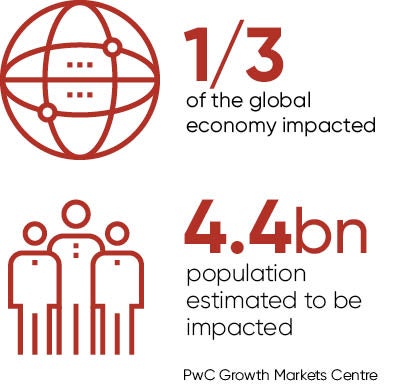It is the largest infrastructure programme the world has ever known, with six economic corridors, across 65 countries, touching 4.4 billion people and one third of the global economy. According to the ratings agency Fitch, $900 billion has already been committed to investments in core infrastructure including roads, seaports, airports, power plants, pipelines, waste and water management facilities, and telecommunications.
China’s ambitious BRI is more than a geopolitical exercise by Beijing. David Wijeratne, Growth Markets Centre leader at PwC, says the BRI goals are multi-pronged as it provides markets to digest China’s industrial overcapacity while also facilitating trade with and between the participating 65 countries, in addition to strengthening its diplomatic relations across the six economic corridors and globally. It is what China is calling a win-win scenario.
“China wants to be known as the world’s leading developer of complex infrastructure projects and the Belt and Road Initiative is a programme to showcase its growing capabilities,” says Mr Wijeratne. “The 12,000km-plus railway from Yiwu in eastern China to Barking in the UK demonstrates its maturing world-class capabilities to the rest of the world.” Such infrastructure not only benefits China, but also millions of consumers, across the 65 participating countries.
However, the BRI is such a massive ambition that even with all its resources, people, expertise and financing, China is still keen to develop partnerships with foreign companies to bring its vision to life. In May, China’s President Xi Jinping invited 29 heads of state and hundreds of business leaders to a Belt and Road summit, which according to Gabriel Wong, Belt and Road leader, PwC China, “was not only intended to align the interests of the Belt and Road participating countries, but also mobilise participation from other nations and especially foreign companies ”.

In its recent report, Repaving the Ancient Silk Routes, PwC has identified six areas in which companies can participate. These are investment of assets, partnerships in engineering, procurement and construction, international project management, supply of construction equipment, and operation and divestment of assets.
However, Mr Wijeratne points out that a construction project is just the start of the commercial opportunities. “Once a port, for instance, has been built, an entire ecosystem arises around it. You need housing, retail, healthcare, education and so on. Although it might not be immediately obvious, there will be opportunities further down the line for companies outside the infrastructure sector.”
As a unique multi-decade programme, the BRI does pose particular risks that go beyond the scope of traditional due diligence considerations, and management and evaluation approaches. There are special geopolitical issues and a variety of different regulatory risks.
Mr Wijeratne says: “Belt and Road partners need to be aware that political regimes can change during a project’s lengthy lifespan and of the inconsistencies in the way in which regulatory regimes operate in monopolistic sectors, such as with power grids or those assets that have a national security interest, including oil refineries and storage tanks.”
As well as considering the government support that a particular project may enjoy, companies need to look carefully at the commercial viability and opportunities for returns. These will differ greatly from project to project, advises Mr Wijeratne. At the delivery stage, companies need to have in place contingency plans that can handle various emerging market challenges, such as inadequate transport links and excessive bureaucracy.
“Its vast, multi-dimensional nature makes the Belt and Road Initiative incredibly complex,” he says. “But by developing a real understanding of its aims and unique challenges, companies around the world can make the most of the incredible opportunities that it offers.”
For more information please visit www.pwc.com/gmc
*Vision and actions on jointly building the Silk Road Economic Belt and 21st-Century Maritime Silk Road, 2015: authors David Wijeratne, Growth Markets Centre leader, PwC, Gabriel Wong, Belt and Road leader, PwC China and Hong Kong, Richard Abadie, PwC UK and global leader of Capital Projects and Infrastructure Group, partner PwC; actual routes may differ and may also extend to encompass other territories as the project develops

